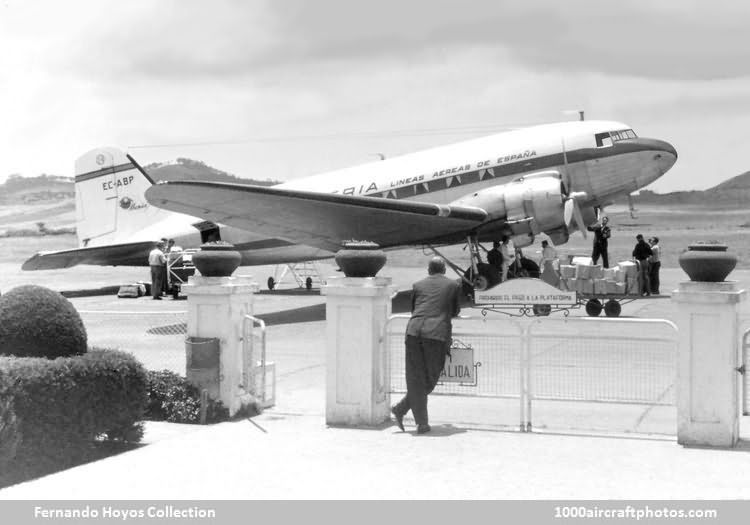02/28/2015. Remarks by Johan Visschedijk: "This aircraft was originally built as a DC-3A-405 C-53 Skytrooper. A total of 397 C-53s were built.
C-53: Whereas the C-47 versions were cargo transports built at Long Beach, California and Oklahoma City, Oklahoma, the C-53 Skytroopers were troop transports built at Santa Monica, California. Powered by 1,200 hp R-1830-92s, C-53s did not have the large cargo loading door, reinforced floor or astrodome of the C-47s. They were fitted with 28 fixed metal seats and a towing cleat for use as glider tugs. 221 built.
XC-53A: C-53 modified in March 1942 to test full-span slotted-flaps and was fitted with hot-air wing de-icing in place of the standard pneumatic de-icer boots of the other military derivatives of the DC-3. The aircraft remained experimental and, at the end of the war, was stored for the USAAF Museum; in 1949, however, it was sold as surplus and modified to a standard close to that of the DC-3C. 1 conversion.
C-53B: C-53 modified in 1942 for operations in the Arctic, with winterized equipment, extra fuselage fuel tanks and an astrodome. 8 conversions.
C-53C: Aircraft ordered by the airlines but taken over by the USAAF while under construction. 17 built.
C-53D: This version differed from the initial C-53 in being fitted with side seats instead of conventional seats. 159 built.
The pictured aircraft was taken on strength by the USAAF under the serial 41-20115 on February 28, 1942, less than three years later it became surplus and went to the RFC on January 24, 1945. It was sold to the Spanish airline Iberia and on January 26, 1946, it was registered as EC-DAK and allotted the fleet number 34. On June 30, it was reregistered EC-ABP. In December 1965 the aircraft was taken on strength by the Spanish AF under the designation T.3-57 and coded 744-57 (later 534-57). It was written off at Madrid-Cuatro Vientos in September 1976 and subsequently scrapped."
Fernando Hoyos adds: "Note the relaxed man at the gate, the open gate to his left and the "no trespassing" sign to his right, nowadays it wouldn't stop people walking onto the platform. The photo was taken from the airport building, the runway in the distance runs parallel to the gates and is oriented to the prevailing trade winds from the north.
On the hills there were farms with dairy cattle and -arguably- the best potato crops on the island. The area is quite damp and foggy and nobody understands why they choose that site for the airport. It is said that, when the time came to build this, the first airport of the island, experts from Germany went to study the island and, after careful consideration, took a map and put a big red cross where the airport is now standing. It was understood by the authorities that it meant there should the new airport be built, but what it really meant was 'build the airport anywhere but here!' So they say.
Another photo, with a CASA 1.131E (license-built Bücker Bü 131 Jungmann) in front, is a general view of the airport from the tarmac, with the control tower and airport terminal on the left. Also on the left – by the CASA, but not seen – is the repair and small aircraft hangar. And that was about all the airport was in the fifties, except for a goldfish fountain and access stairways on the entrance side. All of this is standing nowadays – including the fountain – right by the more modern bigger and functional air-terminal.
My father, Julian Hoyos Quintano, was a radio-navigator with Iberia, initially he flew on DC-4s to South America, later he was posted at Los Rodeos Airport in Tenerife, flying on DC-3s in the Canary Islands, starting early in the morning and hopping from one island to another through evening. Later on he flew on Convair CV-440s and Fokker F-27s."
